|
INITIAL IMPRESSIONS
Having reviewed the big glow FA-220, I was extremely excited to get my hands on the FG-36. I was most interested to look inside and see what had been changed. There are some exterior changes, too, to the gasoline version of the big Saito.
The engine and mount come wonderfully packaged and are well protected during shipping. Also included are an adjustment wrench for the muffler nuts, a carburetor adjustment screwdriver, the muffler and stack, a spark-plug socket, bagged mounting hardware, feeler gauges and tools for valve adjustment, the ignition unit and, of course, a high-quality instruction/ operation manual. Lots of goodies to look at and go through!
The exteriors fine bead-blasted finish is brilliant. The casting quality is perfect, as is all the exterior machine work. The most noticeable differences between the FG-36 and the FA-220 are the new gas pump-style carburetor, the head that accommodates an NGK-CM6 spark plug (instead of a regular glow plug) and the larger muffler. One other neat thing I noticed almost immediately is that the throttle arm comes with a ball linkage installed, and its a straight pull linkage! The throttle hook-up couldnt be easier than on this engine!
RUNNING
As with all Saitos, the instruction booklet is excellent and gives precise instructions on all aspects of break-in and running. Note that you must use the included aluminum mount; it acts as a heat sink, and if you run the engine without it, it may overheat.
The fuel can be any regular or unleaded gasoline mixed in a 20:1 ratio with a good-quality brand of air-cooled 2-stroke motor oil. I chose Pennzoil 2-stroke oil, as I use it in many engines I run. After break-in, you can use a mix of 30:1, but make sure that youve run the engine in adequately before you switch to the fuel mix with less oil.
For break-in, plug the ignition unit into a 4.8V to 6V 4- or 5-cell Ni-Cd or a NiMH pack of at least 1000mAh capacity. An 18×8 or 19×8 prop is recommended for break-in, and of course, you must ensure that all the external plumbing is gasoline-compatible. I used an APC 18×8 prop.
Test conditions at 1,000 ft. above sea level
1 Temperature73 deg. F
2 Humidity85% humidity
3 Barometric pressure29.4 in. of mercury
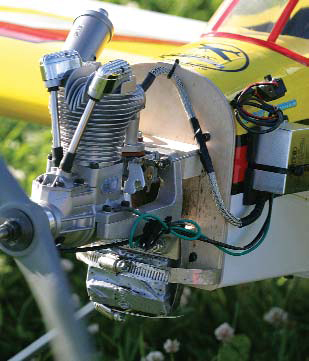 I measured rpm, cylinder-head and exhaust-gas temperatures (CHT and EGT) with the RCATS data-telemetry system. I also confirmed the rpm with a hand-held Glowbee tach. I measured rpm, cylinder-head and exhaust-gas temperatures (CHT and EGT) with the RCATS data-telemetry system. I also confirmed the rpm with a hand-held Glowbee tach.
Set up on my test stand, the engine was easily hand-started after I had turned it through compression a number of times to prime the fuel line. The booklet says that electric starting is preferred, but with the docile characteristics of the auto-advancing ignition unit, hand-starting is easy. As long as you wear a glove to protect yourself from the sharp edges on some props, I recommend it. For the first 10 minutes of running, youre told not to exceed 4,000rpm. In later runs, I noticed that the carb had been very well set at the factory for higher rpm. Hardly any adjustments were necessary! A total of 40 minutes run time is required before you can fly, or in this case prop-test, this engine.
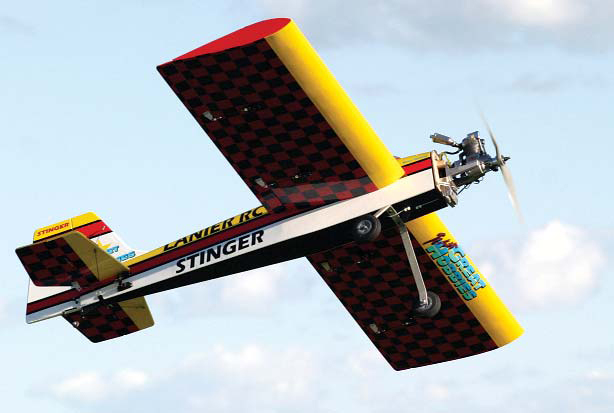 I ran the Zinger props for a direct comparison with the Saito FA-220A reviewed in the November 2005 issue. It is interesting to note that the FG-36 runs at just slightly lower top-end rpm than the glow fuel version on 10 percent nitro and idles noticeably lower as well. The engine is quite capable of running large props without overheating or backfiring. Just keep in mind that it may predetonate if its set too lean. Throughout the bench tests, the engine behaved perfectly with easy one- or two-flip starts. hot or cold, and a low, reliable idle setting was easy to achieve. I was quite impressed. I ran the Zinger props for a direct comparison with the Saito FA-220A reviewed in the November 2005 issue. It is interesting to note that the FG-36 runs at just slightly lower top-end rpm than the glow fuel version on 10 percent nitro and idles noticeably lower as well. The engine is quite capable of running large props without overheating or backfiring. Just keep in mind that it may predetonate if its set too lean. Throughout the bench tests, the engine behaved perfectly with easy one- or two-flip starts. hot or cold, and a low, reliable idle setting was easy to achieve. I was quite impressed.
TEST-FLYING
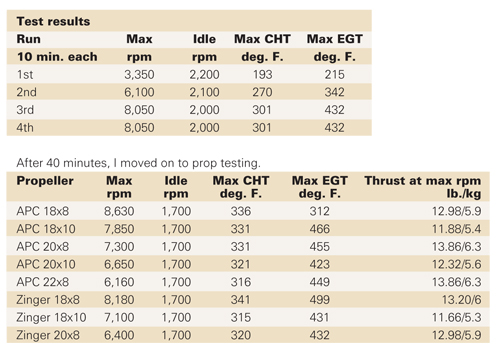 To wring out the FG-36, I mounted the engine on my Lanier Stinger ARFa favorite flyer for my tests of larger engines. With the engine mounted, ignition and a 2700mAh battery pack installed, the planes dry weight was over 15 pounds. I had a Du-Bro 24-ounce tank sitting on the CGmore than enough for 20-minute-plus flights. I chose an APC 20×8 prop for good thrust and an in-flight rpm within the recommended values of 7,000 to 9,000. The large Saito was easy to hand-start at the field. I flipped the prop through compression half a dozen times with the ignition off to move fuel to the carb. Just a few flips after turning on the ignition brought the engine to life. I set the top end to just over 7,000rpm so that it would unload in the air and stay in the recommended range. The idle was more than capable of ticking over at just above 1,200rpm by this point, but I conservatively set it at 1,500 just to reduce any chance of a dead-stick. To wring out the FG-36, I mounted the engine on my Lanier Stinger ARFa favorite flyer for my tests of larger engines. With the engine mounted, ignition and a 2700mAh battery pack installed, the planes dry weight was over 15 pounds. I had a Du-Bro 24-ounce tank sitting on the CGmore than enough for 20-minute-plus flights. I chose an APC 20×8 prop for good thrust and an in-flight rpm within the recommended values of 7,000 to 9,000. The large Saito was easy to hand-start at the field. I flipped the prop through compression half a dozen times with the ignition off to move fuel to the carb. Just a few flips after turning on the ignition brought the engine to life. I set the top end to just over 7,000rpm so that it would unload in the air and stay in the recommended range. The idle was more than capable of ticking over at just above 1,200rpm by this point, but I conservatively set it at 1,500 just to reduce any chance of a dead-stick.
Sound level readings taken with my RadioShack digital meter at approximately 10 feet from the aircraft running wide open and sitting on the grass runway gave me the following readings: 91dB in front, 92dB to the left, 89dB right and 87dB rear. The engine note is quite enjoyable to listen to, and when the plane is in the air, the perceived sound level is quite low. The sound is really amazing and makes this engine ideal for any number of scale-type airframes.
Flying the Stinger was effortless, as the engine gives a nearly 1:1 power-to-weight ratio. Takeoffs were quick, and the throttle response was excellent. In the air, the engine easily powered through multiple loops, rolls and inverted flight, snaps and stall turns, etc. I did notice that in a few high-G maneuvers, the |
|
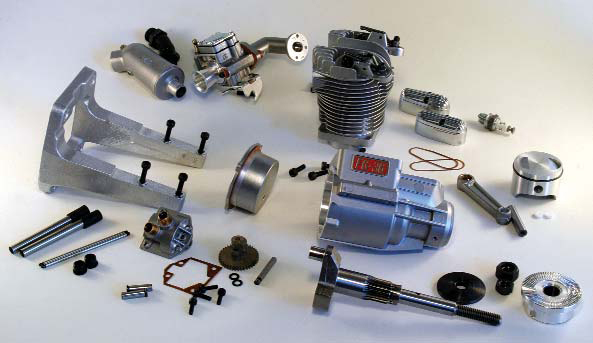 CLOSER INSPECTION CLOSER INSPECTION
Disassembling the FG-36 doesnt pose any problems, but I recommend that you t the pros at Horizon Hobbys service department handle any repair work (especially while the engine is still under warranty).The crankcase is a lovely aluminum casting housing the open rear and sealed front ball bearings. It was obviously CNC-machined inside, as the work is flawless. The has a fine glass bead finish and looks great. I didnt see even one single casting flaw. The cast-aluminum backplate has the same exterior treatment. A paper gasket seals against oil leakssomething rarely seen in a 4-stroke.The Saito FG-36s cylinder/head is manufactured just like the smaller displacement engines in the Saito line. The cast-aluminum head and cylinder are one unit, and the interior has a true chrome plating that makes this a ringed, AAC-type engine. The rocker boxes are each attached to this main casting with a cap-head screw. The single intake and exhaust poppet valves are the same size and placed symmetrically in the hemispherical combustion chamber. A bronze valve guide is pressed into place, but the valves themselves seat directly on the aluminum cylinder casting. The head is bored for a CM-6 spark plug.The beefy crankshaft is a one-piece steel forging. The crank is beautifully machined with a solid crankpin and a dual cutaway counterbalance. The main shaft journal has been drilled for lightness.The cast-aluminum piston has an unpinned cast-iron ring. The skirt features a dual cutaway for clearing the crankshaft counterbalance. There are also two machined areas for valve clearance on the top; this prevents any contact between the valves and the piston at high rpm. The tubular steel wristpin rides in non-bushed bosses cast into the piston. Two Teflon pads prevent contact between the free floating wristpin and the cylinder wall.Unlike the non-bushed glow version, the cast-aluminum connecting rod has a bronze bushing on the lower end. Both versions have a non-bushed upper end. There are two oil holes on the lower end and one on the upper end to make sure that enough lubrication reaches the crank and wristpin areas.The valves and valve train follow the typical practice of using two steel valves of similar size. The springs are held on with split, tapered collets (like those on some full-size auto engines). The one-piece cam gear/cam lobe unit rides on a steel shaft and transfers the motion via hardened steel cam followers that run in bronze bushings. The tubular steel pushrods (with hardened-steel ends) run in tubular pushrod covers and transfer movement from the followers to the rocker arms. The rocker arms are steel castings that pivot on a thread-in-place steel pin. Adjust the valves with a setscrew and a locknut. The vast valve covers are chrome plated and sealed with a paper gasket. The prop-drive washer is machined bar-stock aluminum and has a magnet to trigger the Hall-effect sensor mounted on the lower front end of the crankcase. The drive washer is held in place by a tapered-steel split collet and setscrew that engages a slot in the crankshaft to guarantee that the ignition timing will not change. The prop washer and locknuts are steel and have a black-oxide finish.The 2-needle carburetor has a diaphragm pump similar to those on Walbro carbs. It uses a rotating-barrel design (plastic barrel and aluminum housing). A cast-aluminum elbow is connected to the intake, and an aluminum velocity stack on the intake side rounds out the system.The baffled muffler is shorter than that of the glow version and is machined out of aluminum castings. A threaded steel elbow and locknuts allow the carb to be positioned wherever needed. There isnt a pressure nipple and the hole is blocked, as no pressure is required with a pumping carburetor.
|
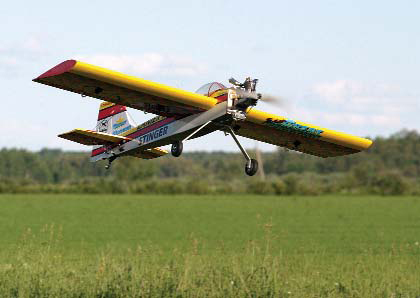 engine seemed to sag a little before powering up; this is more than likely the result of a very momentary fuel starvation. Otherwise, the engine ran perfectly. I was able to gain a few 100 feet in a vertical climb before running out of momentum, and this confirmed my thrust measurements on the test bench. engine seemed to sag a little before powering up; this is more than likely the result of a very momentary fuel starvation. Otherwise, the engine ran perfectly. I was able to gain a few 100 feet in a vertical climb before running out of momentum, and this confirmed my thrust measurements on the test bench.
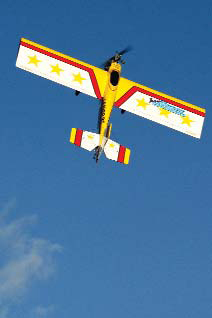 All in all, the engine performed as I expected just beautifully! At least two 15-minute flights are possible with a 24-ounce tank. A smaller 16-ounce tank should give a solid 20-minute flight with fuel to spare. All in all, the engine performed as I expected just beautifully! At least two 15-minute flights are possible with a 24-ounce tank. A smaller 16-ounce tank should give a solid 20-minute flight with fuel to spare.
CONCLUSION
Saito has taken a proven glow engine and given the modeling world a great gas-burning alternative. The engine produces nearly as much power as and with the economy, ease and reliability of a well-behaved sparkignition system. With its unique sound and easy-tohandle attitude, the FG-36 is equally suited to scale, sport, aerobatic and Sunday flyer types. Great throttle ability and low fuel consumption are two of its other key features. And finally, a low exhaust note that will be accepted at even the strictest flying fields makes this one a winner in every respect! I guarantee you wont be disappointed with the Saito FG-36 in your next model.
LinksAPC Propellers, distributed by Landing Products, www.apcprop.com, (530) 661-0399
Horizon Hobby Distributors, www.horizonhobby.com, (877) 504-0233
Saito Airplane Engines, distributed by Horizon Hobby Distributors
Zinger Propellers, www.zingerpropeller.com, (310) 539-2313
|
|

